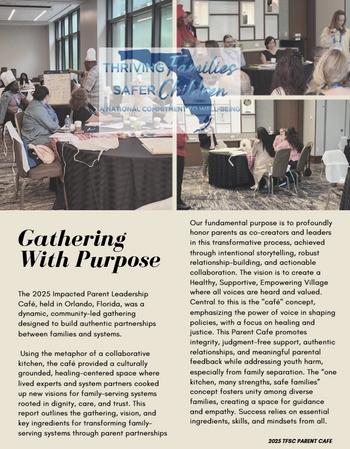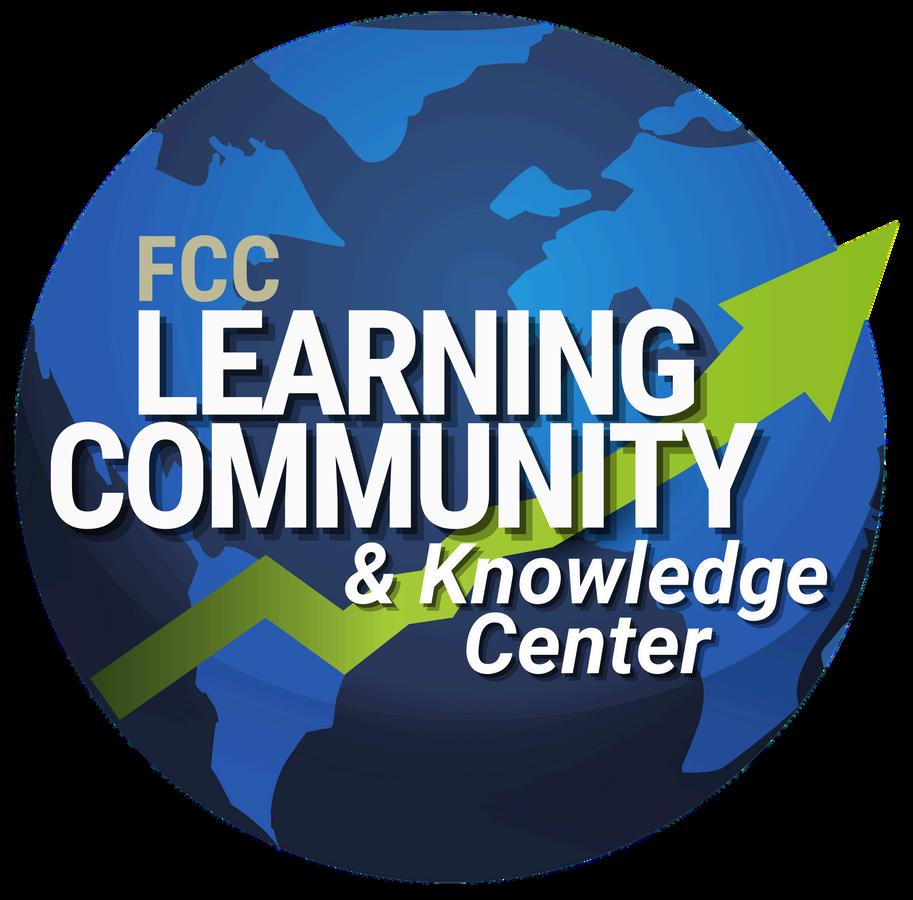


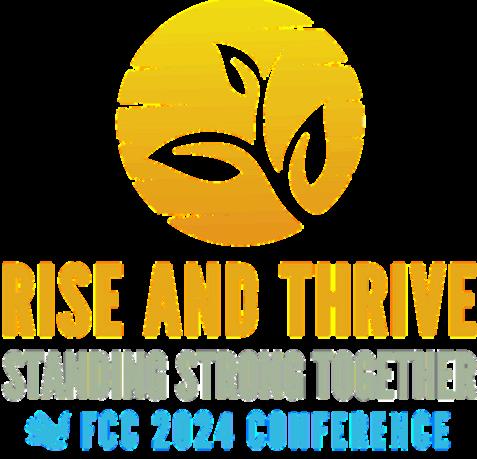

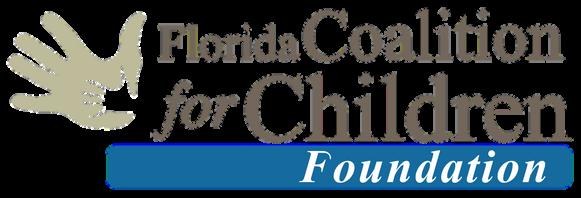



WRITTEN BY:
DR. PATRICIA
NELLIUS-GUTHRIE
FCCEVP&Chief
2025 FCC Conference Community Café Forums Executive Summary
PUBLISHED BY:


I N T R O D U C T I O N
I N T R O D U C T I O N
On July 13-15, 2025, the Florida Coalition for Children Foundation (FCCF) convened its fifth annual Community Café Forum at its “Resilient Communities Meaningful Change” Conference event. The Cafés engaged 550 individuals from across the statewide community of practice who joined to help set strategic direction for 2025-2026. The FCCF Community Café Forums were established in 2021. The work has advanced significantly since that time. For more details and historical background please refer to the 2021 Executive Summary, the 2022 Executive Summary, the 2023 Executive Summary, and the 2024 Executive Summary
Each Community Café forum was co-facilitated by a team of subject matter experts, and individuals with lived expertise, centered around one of the five predefined priority areas using data, research and the experience of those who have been entrenched in the work and possess lived expertise. Each of the groups reflected on:
Where we are as a state regarding the topic
The collective vision for the future
The strategies, tactics, and innovations needed to realize the collective vision
In the spirit of inclusion, collaboration, and collective impact, the FCC Learning Community has adopted the Community Café Forum process to maintain a pulse on the ever-changing landscape of child and family well-being across the state of Florida. This enables the community of practice to annually review key priorities and goals, report progress and results, and realign strategic direction toward the collective future vision.
To continue the work accomplished in the Community Café space between 2021-2024, the FCC hosted its fifth annual Community Café Forum in July 2025, with the addition of three Policy Café forums. The 2025 Cafés were attended by over 550 youth, parents, system professionals, community members, and partners.
The 2025 Cafes included:
Dually Served/High Needs Populations and Their Families
Cassandra Blakely, Senior Training and Technical Assistant Coordinator, Human Services Division, American Institutes for Research
Nathan Scott, Child & Family Well-Being System Coordinator, Florida Department of Health, Sarasota County Health & Human Services/Family Safety Alliance
Impacted Parents and Youth with Lived Experience
Shrounda Selivanoff, Parent with lived experience and Kinship Caregiver/PG custodian. Shrounda has been doing lived experience work for 15 years. Shrounda works for the Washington Office of Defense
Jewel Sullivan, Lived Experience Advocate
Maria Gagnon, New England Association of Child Welfare Commissioners and Directors
Matt Anderson, Imagination Factory,Building Communities for Creative Change
Mandated Reporting and Maltreatment Definitions
Sarah Catherine Williams, Senior Research Scientist, Child Trends
Audrey Carmical, Vice President for Legal and Regulatory Affairs, Texas Alliance of Child and Family Services
Chelsy Alexander, Family Support Network Coordinator, Texas Alliance of Child and Family Services
Youth (with lived expertise) Leadership
JR Minter, Advocacy Director, Selfless Love Foundation
Janessa Collins, Advocacy Coordinator, Selfless Love Foundation
Parent (with lived expertise) Leadership and Advisory Council Development
Christina Romero, Executive Director, (PATH)
Jay Vermillion, Consultant/Trainer, (NCFIE)
Policy Café 1: Dually Served/High Needs
Populations
and Their Families
Presenters
Cassandra Blakely, Senior Training and Technical Assistant Coordinator, Human Services Division, American Institutes for Research
Nathan Scott, Child & Family Well-Being System Coordinator, Florida Department of Health, Sarasota County Health & Human Services/Family Safety Alliance
The focus of this Café was on high need, highacuity youth, living in the community in various caregiver (biological, adoptive, or relative) living arrangements who have struggled to access adequate behavioral health or related services to safely maintain the youth in the home. These youths often touch and exhaust resources available through multiple systems until reaching the threshold where caregivers feel unable to manage, often leading to out-ofhome placements. High acuity includes emotional, mental, physical, and behavioral challenges, frequently with co-occurring substance use, developmental disabilities, and other compounded factors.
COMMUNITY POLICY CAFÉ FORUMS (3)
COMMUNITY POLICY CAFÉ FORUMS (3)
A new addition to this year’s Conference included three highly specialized “hot topic” Policy Café forums bringing together national thought leaders and experts to share research and best practices as well trends and themes with more than 300 participants present to contribute toward thought leadership dialogue, strategy, and planning. Outlined below are the summaries of each of the Café Forums.
Socioeconomic challenges can compound issues for families who often lack resources and face significant hardships like job loss. These stressors can affect family safety and may lead to aggression toward children, further escalation, and system involvement. Post-adoption youth are commonly identified among the highacuity demographic, typically having deepseated trauma and adoptive parents struggling with insufficient support and resources. Systemic issues include unclear responsibility for costs, fragmented and duplicative service delivery, and a lack of cross-system collaboration. Service providers may lack sufficient knowledge of systems, offer insufficient recommendations, and underestimate the need for a multisystem collaborative process to manage the needs of complex youth and their families.
A new addition to this year ’ s Conference included three highly specialized “hot topic” Policy Café forums bringing together national thought leaders and experts to share research and best practices as well trends and themes
Frequent reliance on psychotropic medications that are often started at a young age and continually layered without thorough clinical reassessment are often started at a young age without thorough clinical reassessment. Medication regimens can become overly complex, sometimes leading to treatment of side effects rather than underlying issues. There are also concerns about long-term harmful effects as youth transition into adulthood and potentially discontinue medications without proper support. The systems' wellmeaning but siloed responses often result in treating symptoms (with medication) rather than addressing trauma and adverse experiences in a well-coordinated and planful manner.
Opportunities for early interventions or off-ramps are often missed due to lack of collaboration among providers and lack of identification and awareness at early touchpoints (e.g., therapy, OT/PT, pediatricians).
Systematic Challenges and Missed Opportunities

Youths interact with multiple systems over multi-year timelines, with repeated missed opportunities for effective intervention. Each interaction is a potential intervention point, but lack of shared understanding, knowledge, and collaboration leads to missing these critical junctures of opportunity. The result is poor outcomes: increased risk of school dropout, homelessness, recidivism, complex placement histories, and family fatigue. Family and youth engagement is challenging due to accumulated system fatigue and perception that helpers are present only because it’s their job, not out of genuine concern. Resource constraints across systems—child welfare, juvenile justice, behavioral health— limit access to what may actually be needed at each step.Complex, repetitive application and qualification processes are burdensome for families; many cannot access services until situations become severe enough for system involvement. Natural, concrete, and nonclinical supports (like dance, martial arts, art therapy) are rarely considered or offered proactively, despite their potential benefit for youth to engage in prosocial activities, especially for therapy-resistant youths.
Moderate level services are mostly unavailable, leaving services at extremes: outpatient therapy and inpatient treatment, with few to no options in between.
Data and Trends: Noted about the topic
National studies show strong overlap (40–92%) between youth in juvenile justice and those with prior child welfare involvement, with evidence of generational cycles.In Florida, data from Oct–Dec 2023 identified a growing number of dually served youth in out-of-home care for reasons distinct from traditional child protection, including abandonment, caregiver inability to cope, custody relinquishment, adoption breakdowns, youth substance use, and disability. Notable "default system" shifts occur in early adolescence, where juvenile justice takes over responsibility due to systemic processes, often not due to abrupt behavioral changes but policy-driven eligibility shifts. Circuit 12, as an example, shows substantial growth in lockouts (forced out-of-home placements), rising 450% from pre-2022 averages, now straining system resources.Group care placements consume a disproportionate share of budgets relative to the population served, raising equity and resource allocation concerns. The out-of-home care population has halved in recent years, but costs have increased, indicating inefficiencies and rising support needs per youth.

Leveraging Local Resources and Natural Supports

Young people often feel professionals in their lives are involved out of obligation rather than genuine care; voluntary, non-court-ordered programs reported more positive engagement. Attendees were encouraged to identify and share local innovations, such as leveraging existing community alliances and inviting non-system individuals to contribute ideas and support.
Emphasis was placed on trauma responsiveness and individualized approaches—not one-size-fits-all solutions. Discussion focused on the practice of families being excluded from planning meetings, referencing the “nothing about us without us” philosophy.Children thrive best in community environments supported by natural local resources rather than group homes or large systems. Systems should coordinate and share responsibility, including information and resources, for collective impact. Presenters stressed the need for flexible, braided, and blended funding since individual systems are often underfunded and too rigid. Barriers to access and complex navigation processes prevent families from receiving necessary support.
“Discussion ensued regarding collaboration being essential, not optional, across local and larger systems. Integrated data systems and shared language for outcome measurement are important for coordination and would be helpful in better serving this population.”
Community-Based and Wraparound Models
High Fidelity Wraparound was identified as a key model; highlighted programs in Clearwater, Florida (Directions for Living) with targeted interventions for children with homicidal, suicidal, or dual-system involvement needs. The importance of leveraging local expertise (rather than importing national models) and building on what is already present in the community was emphasized. It was noted that some organizations may not be able to fully implement Wraparound but can integrate core principles through shorter, targeted training and coaching.
Community Café Discussion Points
Discussion ensued regarding collaboration being essential, not optional, across local and larger systems. Integrated data systems and shared language for outcome measurement are important for coordination and would be helpful in better serving this population.
Local programs often demonstrate greater flexibility compared to statelevel interventions. Shared funding innovations, such as application processes requiring multiple organizations to partner and each being independently funded for a shared goal.
Recommended resource: NCJFCJ’s National Resource Center on SchoolJustice Partnerships offers guides for drafting MOUs between schools, courts, and partners and addresses confidentiality barriers (e.g., HIPAA, FERPA).
Encouraged breaking out of "this is just how it's done" thinking and adapting successful models from elsewhere.
Cross system and system-wide training (e.g., annual welfare 101 for school staff) fosters relationships, better understanding, and reduces unnecessary referrals. Discussion occurred regarding innovations in system navigation, such as single-entry forms for multiple programs and streamlined access to support.
Suggested Action Items
Review local practices to ensure family and youth voice/choice is central in planning. Explore cross-training and community engagement as ways to enhance relationship-building and innovation. Investigate opportunities for flexible funding to support immediate needs of families.
Examine existing community resources and partnerships for potential expansion and collaboration.
Consult the NCJFCJ resource for improving information sharing and interagency collaboration.
Prepare reflections on current innovation and collaboration for the follow-up session. Foster early strong cross-system collaboration to prevent escalation of high-acuity needs. Develop and offer a menu of non-clinical, natural supports to supplement traditional therapy models for youth. Regularly reassess medication strategies and focus on addressing underlying trauma and stress factors.
Streamline access to services for families, reducing application complexity and increasing service availability.
Equitably allocate resources across all out-of-home care populations to address growing costs and needs.
Reflect on internal system practices and advocate for restructuring to facilitate better outcomes for youth and families.
Acknowledge that staff are doing difficult work within an inherently flawed system "stacked against them."
Recognition that the only way forward may involve substantial system restructuring, prioritizing collaboration, innovation, and new models of service delivery.
Increase/improve the awareness and openness among local providers of opportunities to braid natural/normative community resources with formal system programming all along the service continuum.
In closing, the participants were prompted to reflect on personal cases and structural factors making it difficult to support families, as well as the impact on leveraging family strengths, and were encouraged to shift from diagnosis to solution-seeking, with a focus on concrete, actionable changes to support high-acuity youth and their families.

“Increase/improve
the awareness and openness among local providers of opportunities to braid natural/normative community resources with formal system programming all along the service continuum.”
Presenters
Shrounda Selivanoff, Parent with lived experience and Kinship Caregiver/PG custodian. Shrounda has been doing lived experience work for 15 years. Shrounda works for the Washington Office of Defense
Jewel Sullivan, Lived Experience Advocate
Maria Gagnon, New England Association of Child Welfare Commissioners and Directors
Matt Anderson, Imagination Factory- Building Communities for Creative Change
This Café was attended by 125 participants and centered on differentiating Transactional versus Transformational change. Nationwide data and outcomes show entry into the child welfare system is harmful to families.It is important for those with lived experience to be equitably compensated. There is a trend in compensating lived experience professionals in ways that do not convey their value, and we must look at lived experience differently. It is important to be in relationships with lived experience experts to learn at every level. Two key concepts explored were the difference between charity (compliance to a law or expectation) versus solidarity (truly focusing on the value added by the lived experience inclusion).
“Family Engagement” is required in Child Welfare, but what is the goal of engaging families? Building Trust, Connection, Social Connections, Awareness, Buy In, Empathy, and Shifting the Lens of the System. How do you know these things are occurring? Outcomes will show success, individually the person feels their needs are met, the individual shares they feel heard. Quote: “If you are here to help me you are wasting your time. If you are here because you know your liberation is tied to my liberation, then let’s talk.”
Transactional skit (led by Shrounda Selivanoff):
Transactional skit #1 Planning meeting: Boxes were checked that people with lived experience were invited along with CLS, CMO’s, GAL, parent, etc. Matt and Shrounda interacted superficially with vague comments.
Transactional skit #2: Stakeholder meeting. The Stakeholders introduced professionals with extended credentials and included a lived experience person. The skit stemmed around the “required legislation” in lived experience and the standard once a month meeting. Child welfare acronyms were used with the lived experience person not understanding the discussion. Lived Experience voice was dismissed. She felt small, uninterested and she felt “dumb” given the credentials. The Lived Experience person stated she felt small.
Transformational skits (led by Maria Gagnon):
Transformational Planning meeting skit #1: The goal is to identify how lived experience can speak to the meeting content and better prepare for a quality outcome, not just checking the boxes.
Discarding the extra stakeholders and plan WITH the lived experience
Work around their schedules
No need to elaborate on credentials or titles, make the room comfortable for the lived experience
Start with the lived experience person
Be comfortable “unlearning” bad habits when working towards compliance to lived experience. The Unlearning of Child Welfare- Matt Anderson. Think about the needs of the lived experience person - offer options to attend and accommodations.
Offer practice sessions and be clear as to what the goal of the meeting is
Check in on acronyms and child welfare language- consider using a list of CW terms
Ask the “human” aspect of the goal
Reiterate and rephrase the progress of the meeting often to ensure everyone is understanding Investment in lived experiences and growing the youth and parent – create polished new level leaders
Allow/encourage the lived experience to ask questions
st,
As of July 1 all CBCs were contractually required to host a Youth and Parent Advisory Council. To achieve this contract requirement some may inadvertently approach this opportunity in a transactional manner to ensure they meet contractual obligations versus focusing on creating change by elevating the presence of family voice.
Policy change for lived experience inclusion will include key factors:
Define the goal of the meeting
Have a clear path and agenda for all parties/meetings
Be comfortable being uncomfortable in making change
Stay committed to driving change despite the comfort level and barriersbe brave, be courageous, and continue to push back the status quo.
The six systems of change (The Water of Systems Change template)
Structural Change 1.Policy 2.Practice 3.Money
Relational Change
1.Relationships and Connections 2.Power Dynamics
Transformational Change- this is where system change occurs
#1 Mental models
Session #1 Takeaways:
·Authentic engagement
·Be comfortable with change
·Slow down
·Be intentional in making change and doing the work
·Be open to listening
·It’s ok that we inherited “the system”, however we are perpetuating the dysfunction
“As of July 1 all CBCs are contractually required to host a Youth and Parent Advisory Council ” st,
Small Group Session #2: Takeaways from the three questions for consideration below
Consider the presentation – what resonated with you and what barriers do you think would keep you from a call to action?
Bringing humanity back to Child Welfare
Adequate Training
Self-Doubt
Caseload size
Inability to communicate emotions can be seen as a mental health issue or aggression in parents
Youth led staffings
Empathy
Need more communication
Preparing professionals for having trauma informed conversations
Teach professionals how to obtain youth and parent desires and advocate for this
Reduce institutionalization for youth as relationships and trust are not built here
Too much policy and less relationships
Legislation updates needed
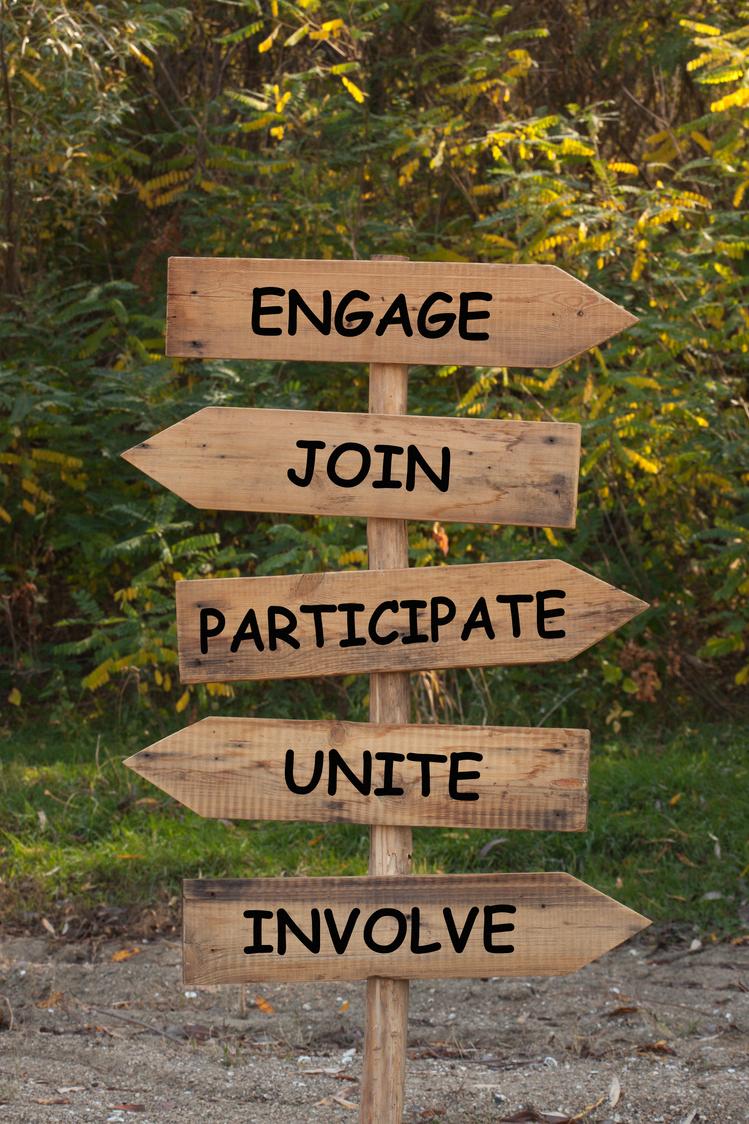
What are some strategies and behaviors that can be used to enhance genuine and thoughtful collaboration with individuals with lived experience?
“Do not make your stress our stress”case worker workloads, judicial requirements, etc.
Help children to get to their achieved goal and individualize planning
Train workers on lived experience and value the meaning of this – train staff, explain how this feedback can be used to make change.
What are the 3-5 specific time sensitive suggestions (within 6 months) that you can do to improve communication with people with lived experience?
Keep sharing stories
Every youth should have a mentor AND reverse mentorship. Peer to Peer supports and mentorships- need agencies that have these in place. Being creative for payments to lived experience
Keep the theme positive
Be sure to utilize other counties and states (Iowa was mentioned as a strong state); you do not have to wait until a program comes to your area. Be comfortable growing a program locally
Handouts were provided to the audience at the close of thesecond session. Click the titles below for the documents. Definitions
Types of connections in child welfare Resources for Engaging Individuals with Lived Experience Effectively From Transactional to Relational
Policy Café 3. Mandated Reporting
Presenters:
Sarah Catherine Williams, Child Trends
Audrey Carmical, Texas Alliance of Child and Family Services
Chelsy Alexander, Texas Alliance of Child and Family Services
This café was attended by 120 participants and featured Child Trends sharing an overview of national mandated reporting trends, definitions, policies, and practices. Members of the Texas Alliance shared their experience and impact of the changes the state of Texas has seen since implementing policy, practice, and cultural shifts after the change in statutory language and definition of neglect.
Key Texas Reforms:
Neglect Definition Changes: The neglect definition now specifies "blatant" disregard for the consequences of an act or failure to act that results in harm to the child or creates “immediate” danger to the child's physical health or safety. Texas Legislature Bill text.
Reporting System Updates:
Eliminated anonymous reporting
Texas receives approximately 300,000 calls annually, with 40% screened out or directed to alternative response system
Removed non-emergency removal provisions—if a situation isn't serious enough for immediate removal, non-emergency removal is not needed
Philosophy Shift: Texas moved away from their former motto of "err on the side of calling." Their state intake division has revamped mandated reporter training to focus on preventive frameworks, emphasizing what NOT to call in and adopting more of a community support model. Many reporters’ express concerns about having limited alternatives.
Training and Outcomes: As of 2023, Texas implemented modified training and observed a drop in mandated reporting (though other factors may have contributed). They are working to reduce poverty-only calls.
Following the presentations from Child Trends and Texas Alliance staff, conference participants were divided into groups to explore the following question: "If our goal was to keep over-reported families living in poverty as neglectful, what practices would we make sure to keep in place?"
Café Responses:
Continue advertising the 1-800 hotline number
Update messaging to reflect a helper role rather than punitive approach
Change the reporting hotline number to 866-HELP-KIDS or another positive number
Training and Education
Implement annual trainings and preservice education programs that are mandatory for reporters, to include resources to support families
Provide better training on what should and shouldn't be reported
Educate child welfare professionals to buy into the cultural change
Keep training mental health professionals on abuse reporting
Continue requiring family service providers and law enforcement to report
Continue making it difficult for kinship caregivers to enroll in services
Requiring everyone to report everything
Instill fear of being punished if you don't report
Not providing decision-making tools for reporters
Not requiring everyone to take mandated reporter training
Maintain current over-reporting practices
Focus on recruiting more foster parents
Avoid engaging the community
Keep mandated reporters poorly educated many still file "cover your assets" (CYA) reports
Action Steps for Child Welfare System Reform
The groups were then asked to come up with specific action steps to implement meaningful changes,; the following were recommended:
Policy and Legal Framework
Revise language in policies and statutes to reflect a supportive approach
Provide legal support for mandated reporters, including legal exemption protections when appropriate
Shift away from anonymous reporting systems
Communication
and Messaging
Change investigator titles to more social worker-oriented roles that emphasize helping Rebrand DCF as "helpers" rather than enforcers

Train community members on how they can help families
Family-Centered Support (see Darrell Missey’s recent webinar HERE.)
Make information more accessible to families
Connect families with peer support and ensure supports are in place
Listen to families, understand their perspectives, and identify their actual struggles
Develop empathy-based approaches when working with families
Create strength-based approaches instead of punitive measures
Community Resources and Involvement
Increase community involvement, especially in small, underserved areas
Expand resources to areas that currently lack adequate support
Place more resources directly in communities
Advise reporters on how they can constructively help families
Improve collaboration with law enforcement
These action steps represent a comprehensive shift toward a more supportive, family-centered approach to child welfare that emphasizes prevention, support, and community engagement over investigation and punishment.
Collectively, the group wanted to shift toward prioritizing help for families, making mandated reporters more supportive, and developing strategies to move the needle forward.

COMMUNITY CAFÉ FORUMS (2)
COMMUNITY CAFÉ FORUMS (2)
“Beyond the Checkbox: Moving from Tokenism to Authentic Engagement”
Presenters
JR Minter, Advocacy Director, Selfless Love Foundation
Janessa Collins, Advocacy Coordinator, Selfless Love Foundation
1. Introduction
Beyond the Checkbox: Moving from Tokenism to Authentic Engagement was a two-part Community Café that brought together 110 youth with lived experience in Florida’s foster care system and system professionals from across the state. The sessions were designed to explore how to move beyond surface-level youth engagement and build long-term, sustainable partnerships rooted in shared power.
These interactive sessions are a modified version of the One Voice Impact tokenization workshop, a tool that agencies can use to guide discussions with young people on these same topics. Both sessions invited participants to reflect on their own experiences, examine how tokenism shows up in practice, how it impacts youth, and what it takes to build real partnerships grounded in shared power, co-ownership, consistency, and trust.
This discussion came at a pivotal time for Florida, as new contractual requirements are being implemented that mandate quarterly meetings and youth engagement boards. These changes reflect a broader shift in expectations, not just that young people will be present, but that they will be actively engaged in shaping systems that affect their lives.
Throughout this summary you will read the highlighted key themes that emerged across both Café sessions, including specific language from young adults, common tensions raised by professionals, and actionable next steps that agencies can begin implementing immediately. From centering youth voice in decisions to building trust and co-ownership, this report aims to support greater consistency in how Florida’s child welfare system engages youth as true partners.
Feeling Valued: Although most groups were unable to answer how they felt most valued in the workforce due to time limitations, one group was able to provide responses. The group indicated that “verbal recognition” made them feel appreciated in their work as well as having opportunities to nominate people for “monthly awards.” Others cited outside opportunities “such as conferences and trainings” as making them feel particularly valued within the field. Participants also mentioned they felt valued when they received support and when there was clear “expectations of the organization for support.” Overall, participants appreciated little acts of support and transparency as well as small tokens such as snacks and water to keep them going.
The discussions focused on shared power, driving the collective commitment to prioritize youth voices in decision-making processes, preventing tokenization, and increasing permanent connections. Participants were challenged to continue these important conversations within their local youth councils to create lasting, positive change in the child welfare system.
“It feels like I’m a box someone checks to say they included youth voice. ”

2. Tokenization: How It Shows Up and How It Feels
One of the most urgent and consistent themes across the Café was the experience of tokenization, a dynamic where young adults are invited to participate, but not genuinely listened to, empowered, or respected as partners. This often takes the form of youth being asked to “speak for all youth,” invited at the last minute, or excluded from decision-making after sharing input.
Participants emphasized that tokenization is not just a missed opportunity, it causes harm. Young people described being used for optics, particularly when asked to share personal stories or trauma without meaningful follow-up or change. This experience leads to disengagement, burnout, and distrust.
In their own words, young adults described the emotional toll:
“It feels like I’m a box someone checks to say they included youth voice.”
“Tokenization is draining.”
“It makes me not want to put my information out there.”
“Disheartened, withdrawn, and almost bullied.”
“Feel like I am at the table but don’t have the mic.”
Several participants noted that tokenization is often unintentional — rooted in good intentions but poor execution. Addressing this requires more than inviting youth to the table; it demands shifting mindsets toward shared power and co-creation.
Authentic engagement means preparing both youth and adults for partnership, ensuring consistent follow-up, and embedding youth leadership into programs, systems, and culture.
Review your current youth engagement practices for signs of unintentional tokenism — such as last-minute invitations, asking for personal stories without support, or collecting input without follow-up.
Audit when and how youth input is used. Identify places where feedback is gathered but not meaningfully applied — and revise those practices to reflect authentic engagement. Co-create engagement expectations with youth. Develop shared agreements that define what meaningful participation looks like and build trust between youth and adults.
Normalize feedback on power dynamics. Consider making “How are we doing on shared power?” a standing question in your meetings.
3. Building Real Feedback Loops
Throughout the Café, young adults emphasized that authentic engagement doesn’t stop at listening, it must lead to tangible change. They expressed frustration with being invited to share ideas or feedback, only to see no clear follow-up, implementation, or acknowledgment. As one participant put it, “It just disappears into a void.”
Participants described deep skepticism about systems that repeatedly ask for youth input but failing to act on it. Many shared stories of making thoughtful recommendations, filling out surveys, or participating in meetings where “everything gets written down, but nothing happens.” When this occurs, they said, it not only undermines trust, but reinforces the feeling of being used rather than valued.
Several key themes emerged around what youth believe a real feedback loop looks like:
Consistency is Key: Engagement should be ongoing, not one-time or occasional. “We want to know when we’ll hear back — not just hope for it.”
Visible Action: Youth need to see what’s changing based on their input. As one participant explained, “You don’t have to say yes to everything, but at least show us what you did with what we said.”
Accountability and Role Clarity: Clear communication about who is responsible for follow-up tasks builds trust. Participants noted that without accountability, “it feels like lip service.” Transparency: Even when ideas cannot be implemented, youth deserve honesty about why. “Tell us the why. Don’t just go quiet.”
Two-Way Communication: Youth want updates and check-ins — not just information extracted from them. As one young adult said, “It has to feel like a conversation, not a transaction.”
In many cases, youth recommended building structured feedback loops into the design of councils, boards, or workgroups. This might include setting timelines for follow-up, identifying a point person for each action item, or visibly tracking progress on shared goals. Several youth also highlighted the value of access to leadership, noting that when system leaders are involved in the loop, “things actually move forward.” Youth suggested these points: people must either be empowered to make decisions on identified priorities or have direct access to someone with decision-making authority. Without this, even well-intentioned feedback loops risk stalling out.
Ultimately, young adults expressed that a real feedback loop validates their effort and shows respect for their contributions. When systems consistently act on feedback, or transparently explain why they can’t, it builds long-term trust and strengthens collaboration.
Next Steps:
Establish response timelines and point people for all feedback gathered from youth (e.g., “You’ll hear from us in weeks,” with a named contact).
Track and share progress on youth-informed recommendations through visual tools (e.g., shared Google Docs, whiteboards, dashboards).
Create a feedback accountability plan within councils or advisory groups, outlining who is responsible for follow-up, when updates will be given, and how decisions will be communicated.
Normalize explaining the “why” when feedback isn’t used — youth deserve transparency even when ideas can’t be implemented.
4. IMPROVING PARTNERSHIPS AND SHARED POWER
Participants emphasized that authentic youthadult partnerships must go beyond surfacelevel inclusion to build trust, shared power, and ongoing collaboration. Young adults described positive partnerships as those rooted in relationship-building, mutual respect, and open communication, rather than tokenized interactions focused only on their lived experience.
A recurring theme was the need for adults to invest time and effort in building real relationships with youth, showing up consistently, following through on commitments, and validating their feelings and perspectives. As one young person said, “We don’t want to just be heard — we want to be believed.”
Several youth noted that access to leadership helps shift power dynamics and build momentum for change. When system leaders engage directly with young people, it signals that their input is valued and actionable. Participants also discussed the importance of co-creating spaces where youth and adults share responsibility for shaping goals, agendas, and outcomes. In these environments, power is not given; it is shared, negotiated, and practiced over time.
At the same time, many youth acknowledged that not all adults enter partnerships with the same mindset. Some may unintentionally dominate conversations, dismiss ideas, or delegate without building true collaboration. Youth emphasized the need for adults to reflect on their own roles, step back when appropriate, and ask themselves: “Am I creating space for youth to lead?”

Young people also shared examples of what helps partnerships thrive:
Clarifying roles and expectations on both sides.
Ongoing preparation and support for youth participants.
Recognition of youth expertise, not just their experience.
Room for mistakes and learning — without punishment or judgment. Ultimately, improving partnerships means moving from youth engagement to youth partnership; a shift that requires intentional practice, humility, and shared accountability. Wong’s “Typology of Youth Participation” provides a clear visual and practical tool to help agencies assess where they are on the spectrum of youth involvement and move toward true power sharing.
Next Steps:
Build in regular relationship-building time between youth and adults outside of formal meetings — e.g., pre-meeting check-ins, casual meetups, or shared planning calls. Ensure access to leadership and create pathways for youth ideas to influence real decisions. Invite decision-makers to co-create with youth, respond directly to their input, and build sustained partnerships that extend beyond one-time events. Co-create agendas and priorities with youth at the start of new initiatives or boards, rather than presenting them with a preset structure. Provide training for both youth and adult partners on youth-adult partnership principles and shared power frameworks (e.g., Wong’s Typology, One Voice Impact Training, Youth Thrive) to increase readiness and reduce unintentional power imbalances.
5. THE PATH FORWARD
The conversations and shared experiences throughout the Café made the direction forward unmistakably clear. Across every discussion, young adults and professionals emphasized the importance of moving from performative engagement to authentic partnership. Participants called for:
Intentional design of youth engagement structures, with clear roles and genuine influence. Transparent processes that build trust through consistent communication and followthrough.
Structured feedback loops that show how input is used, with visible action and accountability.
Shared learning and preparation, including training and support for both youth and adults. Respect, compensation, and access, ensuring that young people are supported and not tokenized.
The message was clear: youth must be involved not just in shaping programs — but in influencing systems and culture. Co-creation, shared power, and long-term investment in youth leadership are not optional if Florida aims to truly engage the voices of those most impacted.
This Café was one step in that journey. The insights, stories, and themes shared offer a powerful foundation for meaningful change if we commit to listening, acting, and building together.
Rather than building new structures from the ground up, agencies can strengthen their efforts by tapping into what’s already working — including frameworks for co-facilitation, guidance for launching or improving youth boards, and microgrant strategies that support youth-led engagement and can assist in recruitment efforts for young adults’ participation. CBC’s already have resources through partners like the Selfless Love Foundation that can be tailored to local needs, and they offer a strong starting point for teams ready to move beyond compliance and toward meaningful partnership.
As Florida rolls out new engagement requirements, recognizing these patterns is essential to ensuring those efforts are meaningful, not performative.

“The message was clear: youth must be involved not just in shaping programs but in influencing systems and culture.”
Steps:
Review existing youth engagement structures (e.g., councils, boards, feedback loops) to ensure they include shared decision-making, defined follow-up timelines, and transparent communication.
Develop or update internal policies to clearly define expectations for youth-adult partnerships, compensation, and participation roles — especially in leadership or advisory spaces.
Create youth-adult partnership development plans that include training, coaching, and reflection opportunities for both youth and system professionals to grow in collaboration.
Community Café 5. Parent Leadership and Advisory Council Development
Christina Romero, Executive Director, (PATH)
Jay Vermillion, Consultant/Trainer, (NCFIE)
Introduction
The Parent (PAC) Café was led by Christina Romero, Executive Director, PATH and Jarred (Jay) Vermillion, National Center for Innovation and Excellence. Jarred and Christina are state and national leaders in the Lived Expertise space and co-lead the Florida Thriving Families Safer Children Parent Advisory Committee Action Team and are part of the Statewide Thriving Families Initiative which is comprised of 50 members from over 36 cross sector partner agencies. TFSC is co-convened by an impacted parent consultant leader, Tiffany Csonka, Visionary Consultant and Patricia Nellius, EVP, Florida Coalition for Children.
There were over 115 individuals from across the statewide SOC present in the Café. The Thriving Families Safer Children PAC vision, “To bravely and radically honor parents as partners in and with our family serving systems throughout Florida” was shared. The goal of the committee was also shared: “To elevate power, create shared decision making and develop parent leadership throughout our policies, practices, and family serving systems in Florida.”
The topic of “Stirring Up Support” used a collaborative kitchen theme to actively engage participants in fostering strong, authentic and mutual partnerships.
The Community Cafe was summarized in a magazine-style format and can be accessed HERE
Gathering with a Purpose
“Gather
‘round our communal kitchen table where collaboration and support simmer like a delicious stew, inviting parents, youth and allies to join the fun...”
